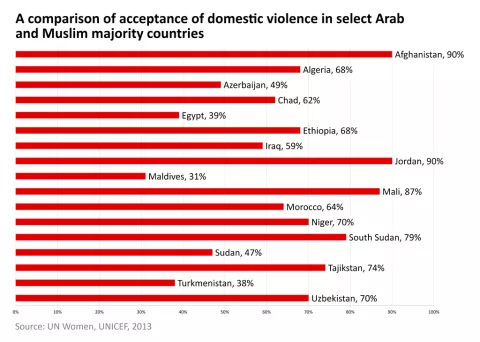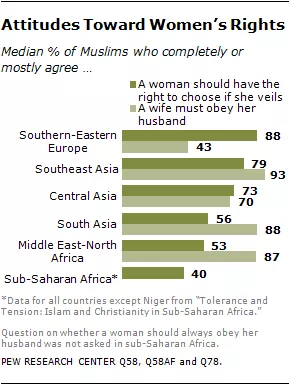Violence against women is a pervasive issue affecting societies worldwide. However, the prevalence, nature, and response to such violence can vary significantly based on cultural, religious, and socio-economic factors. In Muslim-majority countries, these dimensions interact in complex ways to shape the experiences of women facing violenc e. This article explores how cultural and religious factors influence violence against women in these regions, drawing on data and facts to provide a comprehensive analysis.
Prevalence of Violence Against Women
According to the United Nations, approximately 35% of women globally have experienced physical or sexual intimate partner violence or non-partner sexual violence in their lifetime. In Muslim-majority countries, the prevalence rates are often higher. For instance, a 2013 study by the World Health Organization (WHO) found that 37% of women in the Eastern Mediterranean region had experienced physical or sexual intimate partner violence. In Pakistan, the Pakistan Demographic and Health Survey (PDHS) 2017-2018 reported that 28% of women aged 15-49 had experienced physical violence since age 15.
Cultural Factors
1. Patriarchal Norms: Patriarchal norms are deeply embedded in many Muslim-majority societies. These norms often place men in positions of authority over women, limiting women's autonomy and reinforcing gender inequality. The cultural expectation that women should be obedient to their husbands or male guardians can normalize and perpetuate violence as a means of control. For example, in Jordan, a 2012 study found that 47% of women believed that a husband is justified in beating his wife under certain circumstances.
2. Honor and Shame: The concepts of honor and shame play a significant role in many Muslim-majority cultures. Women's behavior is often seen as a reflection of family honor, leading to strict controls over their actions and movements. Violations of these norms, whether real or perceived, can result in honor-based violence. The United Nations Population Fund (UNFPA) estimates that 5,000 women globally are killed each year in honor killings, with a significant number occurring in Muslim-majority countries such as Pakistan, Afghanistan, and Iraq.
3. Social Stigma: Social stigma attached to victims of violence can deter women from reporting abuse. Fear of being ostracized or blamed for the violence often leads women to suffer in silence. In Egypt, the Demographic and Health Survey (DHS) 2014 reported that only 5% of women who experienced physical or sexual violence sought help from formal services.
Religious Factors
1. Misinterpretation of Religious Texts: Islam promotes the dignity and respect of women. But,selective readings of religious texts can be used to justify violence against women. For example, some interpretations of the Quranic verse 4:34, which discusses men's authority over women, have been used to legitimize domestic violence. Scholars and activists argue for contextual and holistic readings of religious texts to counter these misinterpretations.
2. Role of Religious Leaders: Religious leaders in Muslim-majority countries hold significant influence over public opinion and behavior. Their stance on women's rights and violence can either perpetuate harmful practices or promote change. Progressive religious leaders who advocate for gender equality and condemn violence against women play a crucial role in shifting societal attitudes. For instance, in Indonesia, the country's largest Muslim organization, Nahdlatul Ulama, has issued fatwas condemning domestic violence and promoting women's rights.
3. Legal Frameworks Influenced by Sharia: In many Muslim-majority countries, legal systems are influenced by Sharia (Islamic law). While Sharia itself contains provisions that protect women's rights, the way it is implemented can vary widely. In some cases, laws derived from Sharia can be used to restrict women's rights and freedoms. For example, in Saudi Arabia, the male guardianship system, which requires women to obtain permission from a male relative for various activities, has been criticized for enabling and perpetuating violence against women.
Efforts to Address Violence
1. Legislative Reforms: Many Muslim-majority countries have taken steps to address violence against women through legislative reforms. For instance, Turkey's Law No. 6284, enacted in 2012, provides comprehensive measures to protect women from domestic violence. Similarly, Morocco's Law 103-13, passed in 2018, criminalizes various forms of violence against women and provides protection measures for victims.
2. Awareness Campaigns: Awareness campaigns play a crucial role in changing societal attitudes towards violence against women. In Pakistan, the Aurat Foundation has been at the forefront of raising awareness and advocating for women's rights. Their initiatives include community-based awareness programs and media campaigns aimed at changing perceptions and encouraging reporting of violence.
3. Support Services: Providing support services for victims of violence is essential for their safety and recovery. Shelters, hotlines, and counseling services are vital resources for women facing violence. In Malaysia, the Women's Aid Organization (WAO) operates shelters and provides legal aid and counseling services to survivors of domestic violence.
Violence against women in Muslim-majority countries is a multifaceted issue influenced by cultural and religious factors. While patriarchal norms, concepts of honor and shame, and misinterpretations of religious texts contribute to the problem, efforts are being made to address and mitigate these factors. Legislative reforms, awareness campaigns, and support services are critical components in the fight against violence. It is essential to continue challenging harmful cultural and religious practices while promoting interpretations of Islam that uphold the dignity and rights of women. Only through a comprehensive and nuanced approach can meaningful progress be made in eliminating violence against women in these regions.






Comments
Add new comment